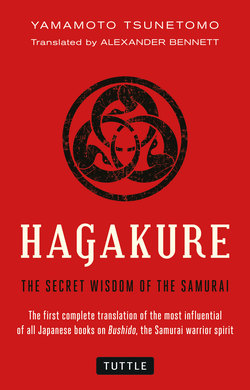Читать книгу Hagakure - Yamamoto Tsunetomo - Страница 6
На сайте Литреса книга снята с продажи.
ОглавлениеFOREWORD
When I heard that Dr. Alexander Bennett was going to translate Hagakure by Yamamoto Jōchō (Tsunetomo), my initial thought was that the final result would surely be very interesting. This is because Dr. Bennett possesses a profound knowledge of, and deep insight into, the world of Japanese bushido. This expertise has been enhanced by his extensive practical experience of the traditional martial arts of Japan, and his proficiency in this domain is highly acclaimed.
First of all, I would like to briefly introduce Dr. Bennett’s extraordinary background and unique experiences in Japan, as doing so will illuminate the reasons why he is such a worthy translator of this classic text. He was born in New Zealand in 1970. In 1987, he came to Japan for the first time as an exchange student. Through participating in club activities at his host high school in Chiba Prefecture, Dr. Bennett stumbled across the traditional budo art of kendo. This experience led to an insatiable fascination with Japan’s martial culture. When his year-long sojourn in Chiba finished, he returned to New Zealand, but it wasn’t long before he was back in Japan for another couple of years, from 1989 to 1991, to further his study of kendo and other martial arts.
Dr. Bennett graduated from the University of Canterbury in his hometown of Christchurch in 1994. He received his Ph.D. in Humanities and Sciences from Kyoto University in 2001. His doctoral dissertation, written in Japanese, was an impressive investigation of bushido that was eventually published in 2009 by Shibunkaku in Kyoto as The Bushi Ethos and its Evolution: An Investigation of Bushidō from the Perspective of the History of Social Thought.
In 2002, Dr. Bennett became a research associate at the International Research Center for Japanese Studies, where I met him for the first time. Following his tenure of research at the IRCJS, he taught Japanese culture at the Faculty of Liberal Arts in Teikyo University, and then moved to his current position as an associate professor at the Division of International Affairs, Kansai University. For many years he has been the driving force behind Kendo World, an endeavor he was instrumental in establishing as the world’s first English language kendo magazine in 2001. Dr. Bennett currently holds the ranks of 7th-dan in kendo, 5th-dan in iaido, and 5th-dan in naginata, and is a living embodiment of the ideal of bunbu-ryōdō—being accomplished in both the literary and military arts.
For quite some time now, he has advocated the practical teaching of zanshin as a key concept in the culture of bushido. What is zanshin? Literally “lingering heart,” simply put it is an important principle in the martial arts which means to maintain psychological and physiological alertness at all times, even after achieving victory in combat or a match. It entails remaining vigilant, calm, and collected after the engagement, and mustering complete control over the surge of adrenaline in your blood. Expressing emotions of joy in victory or anguish in defeat are unacceptable. Throwing one’s arms up in exhilaration shows a lack of vigilance and respect.
Thus, zanshin can be described as a state of mind in which one shows constant awareness and self-control. Dr. Bennett contends that, in the world of the samurai, such a mind-set was developed through the accumulated experience of mortal combat. Showing respect towards one’s adversary in a life-and-death situation, and reminding oneself of the grave danger of dropping one’s guard, even for an instant, is the kind of encounter that nurtures a sense of zanshin. I feel his observations of the importance of zanshin is a critical reminder of an all but forgotten element of samurai culture, that once lost, will also lead to a fading in comprehension of the true essence and lessons of bushido.
When I first came across Dr. Bennett’s theory of zanshin, I was reminded of another Japanese word, mushin (“no-mind”), or mushi (“selflessness”). The term zanshin sounded foreign to my ears, as it does to most Japanese people. In actual fact, zanshin sounds like quite an inconsistent or unstable state of mind to Japanese people, who have long believed that an “empty mind” and “selflessness” is a profound way of living, representing the highest plane of spiritual attainment. How does the lingering mind of zanshin compare with the state of no-mind in mushin? Is it really so important, as Dr. Bennett maintains, that it should be considered the ultimate state of mind in the Japanese martial ways known around the world as budo? These are questions that smolder in the back of my mind. I feel compelled to confess that I have been obsessed with these questions ever since Dr. Bennett brought to my attention the concept of zanshin.
As I ponder such matters, I am intrigued as to what kind of attitude the author of Hagakure had towards ideals reminiscent of zanshin and mushin. Given his acute understanding of such tensions inherent in the lifestyle of the samurai, it is a point of great interest to me to see how Dr. Bennett interprets Yamamoto Jōchō’s theory of bushido. I look forward to scouring his translation of Hagakure to see how he encountered Yamamoto Jōchō, and communicated with him between the lines of the text.
Yamaori Tetsuo
(Former Director of the International Research Center for Japanese Studies)
June 2, 2013
Kyoto
